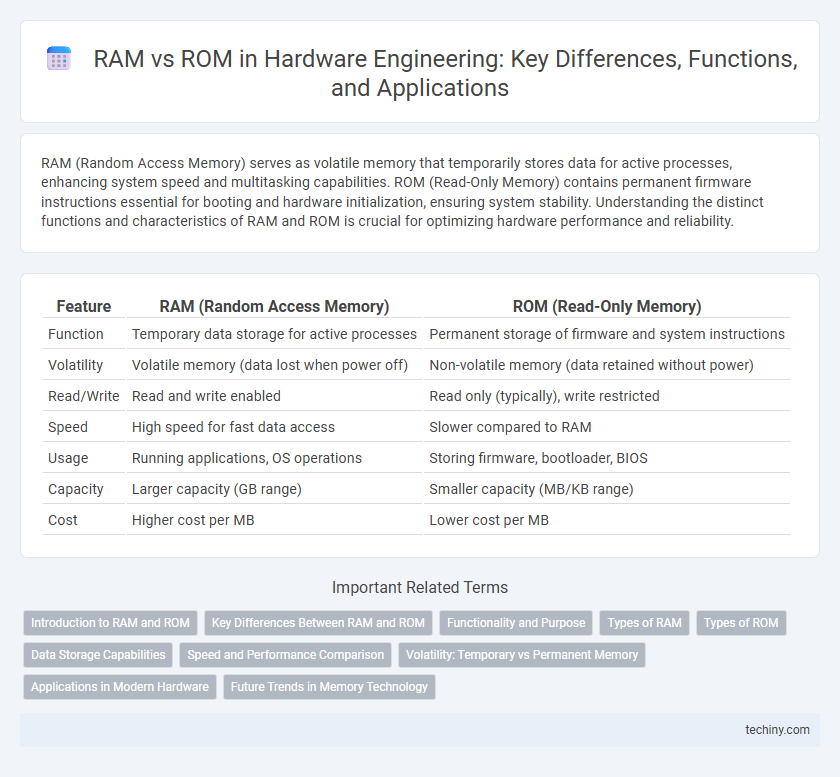RAM (Random Access Memory) serves as volatile memory that temporarily stores data for active processes, enhancing system speed and multitasking capabilities. ROM (Read-Only Memory) contains permanent firmware instructions essential for booting and hardware initialization, ensuring system stability. Understanding the distinct functions and characteristics of RAM and ROM is crucial for optimizing hardware performance and reliability.
Table of Comparison
| Feature | RAM (Random Access Memory) | ROM (Read-Only Memory) |
|---|---|---|
| Function | Temporary data storage for active processes | Permanent storage of firmware and system instructions |
| Volatility | Volatile memory (data lost when power off) | Non-volatile memory (data retained without power) |
| Read/Write | Read and write enabled | Read only (typically), write restricted |
| Speed | High speed for fast data access | Slower compared to RAM |
| Usage | Running applications, OS operations | Storing firmware, bootloader, BIOS |
| Capacity | Larger capacity (GB range) | Smaller capacity (MB/KB range) |
| Cost | Higher cost per MB | Lower cost per MB |
Introduction to RAM and ROM
RAM (Random Access Memory) serves as volatile memory that temporarily stores data and instructions actively used by the CPU, enabling fast read and write operations crucial for system performance. ROM (Read-Only Memory) provides non-volatile storage containing firmware or permanent instructions essential for booting and hardware initialization. Understanding the distinct roles of RAM and ROM is fundamental for optimizing hardware architecture and ensuring efficient data management in computing devices.
Key Differences Between RAM and ROM
RAM (Random Access Memory) is volatile memory used for temporary data storage during active processes, allowing fast read and write access, while ROM (Read-Only Memory) is non-volatile memory that stores permanent instructions essential for booting and firmware operation. RAM's capacity and speed directly influence system performance and multitasking ability, whereas ROM contains fixed data critical for hardware initialization and system integrity. Unlike ROM, RAM requires constant power to retain data, making it essential for dynamic computing tasks but unstable for permanent storage.
Functionality and Purpose
RAM (Random Access Memory) serves as volatile memory that temporarily stores data and instructions for active processes, enabling rapid read and write operations essential for system performance. ROM (Read-Only Memory) is a non-volatile memory used to permanently store firmware and system boot instructions, ensuring critical code is retained even when power is off. The primary functionality difference lies in RAM's role for dynamic, temporary data handling versus ROM's purpose for stable, unalterable code storage.
Types of RAM
Dynamic RAM (DRAM) and Static RAM (SRAM) are the primary types of RAM used in hardware engineering, with DRAM being more common due to its higher density and lower cost, storing data in capacitors that require periodic refreshment. SRAM, in contrast, uses flip-flops to store data, providing faster access times and better reliability but at a higher cost and lower density, making it ideal for cache memory. Variants such as Synchronous DRAM (SDRAM) and Double Data Rate SDRAM (DDR SDRAM) enhance performance by synchronizing with the system clock and enabling faster data transfer rates.
Types of ROM
Read-Only Memory (ROM) types include PROM (Programmable ROM), EPROM (Erasable Programmable ROM), and EEPROM (Electrically Erasable Programmable ROM), each varying in reusability and data retention. PROM can be programmed once after manufacturing, making it useful for permanent code storage, while EPROM is erasable via UV light, allowing data rewriting. EEPROM offers electrical erasure and reprogramming capabilities, enabling in-system updates without removal from the hardware device.
Data Storage Capabilities
RAM (Random Access Memory) provides volatile data storage, enabling rapid read and write access for active processes and temporary data manipulation. ROM (Read-Only Memory) offers non-volatile storage, preserving firmware and critical boot instructions even when power is off. The fundamental difference lies in RAM's ability to modify data dynamically compared to ROM's permanent, unalterable data storage.
Speed and Performance Comparison
RAM offers significantly faster read and write speeds compared to ROM, directly enhancing system performance by enabling quick data access and temporary storage for active processes. ROM, being non-volatile, provides slower, permanent storage mainly for firmware, which does not require frequent updates or rapid data retrieval. The speed disparity means RAM is crucial for multitasking and real-time processing, while ROM's role prioritizes reliability over operational speed.
Volatility: Temporary vs Permanent Memory
RAM (Random Access Memory) is volatile memory that temporarily stores data and instructions needed by the CPU during active processing, losing all information when power is turned off. ROM (Read-Only Memory) is non-volatile and permanently stores critical firmware and system instructions, retaining data even without power. The volatility distinction impacts system performance and data retention, with RAM enabling fast data access and ROM ensuring persistent storage for essential code.
Applications in Modern Hardware
RAM (Random Access Memory) is essential for temporary data storage and fast access in computing devices, enabling smooth multitasking and system responsiveness in laptops, smartphones, and servers. ROM (Read-Only Memory) stores firmware and bootloader instructions critical for initializing hardware during startup in embedded systems, gaming consoles, and industrial controllers. Modern hardware relies on RAM for dynamic operations while ROM ensures persistent storage of foundational software and configurations.
Future Trends in Memory Technology
Emerging memory technologies like MRAM, ReRAM, and PRAM offer faster speeds, higher density, and non-volatility, surpassing traditional RAM and ROM limitations. Integration of 3D stacking and advanced lithography enhances memory capacity and power efficiency, crucial for AI and IoT applications. Future memory solutions aim to bridge the gap between volatile and non-volatile storage, enabling ultra-fast computing with persistent data retention.
RAM vs ROM Infographic

 techiny.com
techiny.com